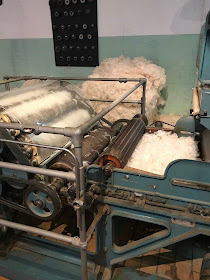This is definitely a place worth visiting, if you are a spinner or a weaver. It's located in an old wool-blanket factory, so there are some rooms dedicated to the old machinery (still all in working order!) that was used to make blankets.
There are other rooms dedicated to the history of jacquard weaving (I'll be blogging about that in a later post), but the major attraction is the Textile Lab, where modern, computer-driven weaving and knitting machines are used by artists to push the boundaries of current tech. Again, for a future post!
So, let's get started.
Quickie tour of the blanket factory:
The factory was in operation between 1900 and 1940, and produced 100% woolen blankets from bales of local wool. The blankets were woven and fulled on site and the entire production chain can be viewed.
The process starts with the "picker" (well, OK, it's called something else in Dutch). The wool shown in the pictures is pretty fantastically clean, and I'm not sure if this was actually the case when this puppy was in current use...but we'll not get picky about this.
[first stop: the picker]
Then, a couple of "carding" steps followed, to produce thin webs of fleece and finally narrow ropes of fleece. Unlike other mills I've visited, this factory didn't use a pindrafter.
[carding, step 1]
[thin fleece mat moving onto second carding step]
[second carding step, producing thin ropes of roving]
The thin rovings that come off the second carder look a lot like those wheels you get from Briggs and Little, called "country roving" - the ones you use to make Cowichan sweaters. See photo below:
[what comes off of the second carder]
These wheels were then used on the "spinner", which was a sort of automated drop-spindle. It thinned and twisted the roving into single-ply yarn.
[the spinner]
Then, weaving ensued. This step wasn't explained fully in the setup (all that was shown was how they set up a warp chain with a machine to do sectional warping - and they didn't demo it with the yarn shown above), but I understood that they produced double-woven pieces of woolen cloth (twill weave) that were then fulled and finally run through the teasel machine. The blankets were of a solid colour, with one side a lighter shade than the other.
The "fuller" took the blankets, soaked in a hot solution of ammonia and soda, and forced them through a pair of rollers, first in one direction and then 90 degrees opposed, to felt the wool fibers. Several passes were required.
[fulling machine]
After fulling, the edges were hemmed and the blanket was run through the "teaseler" a few times: basically a bunch of rollers with nasty burrs on them to raise a nice fluffy pile on the blanket.
[teasel machine]
[closeup of the nasty rollers]
Lots of factors contributed to the downward spiral and eventual death of the factories: the rising popularity of the down-filled or synthetic duvet, the fact that we have central heating in all our houses now, and the rising cost of land which makes selling the factory itself more lucrative than running it as a business.
Wool blankets are a rarity these days. Most folks have one only as a sort of decorative throw, to cuddle under when watching TV on a winter night, or by a summer campfire. Blanket factories were once relatively common in northern Europe, England, and even in on the east coast of the US.









No comments:
Post a Comment